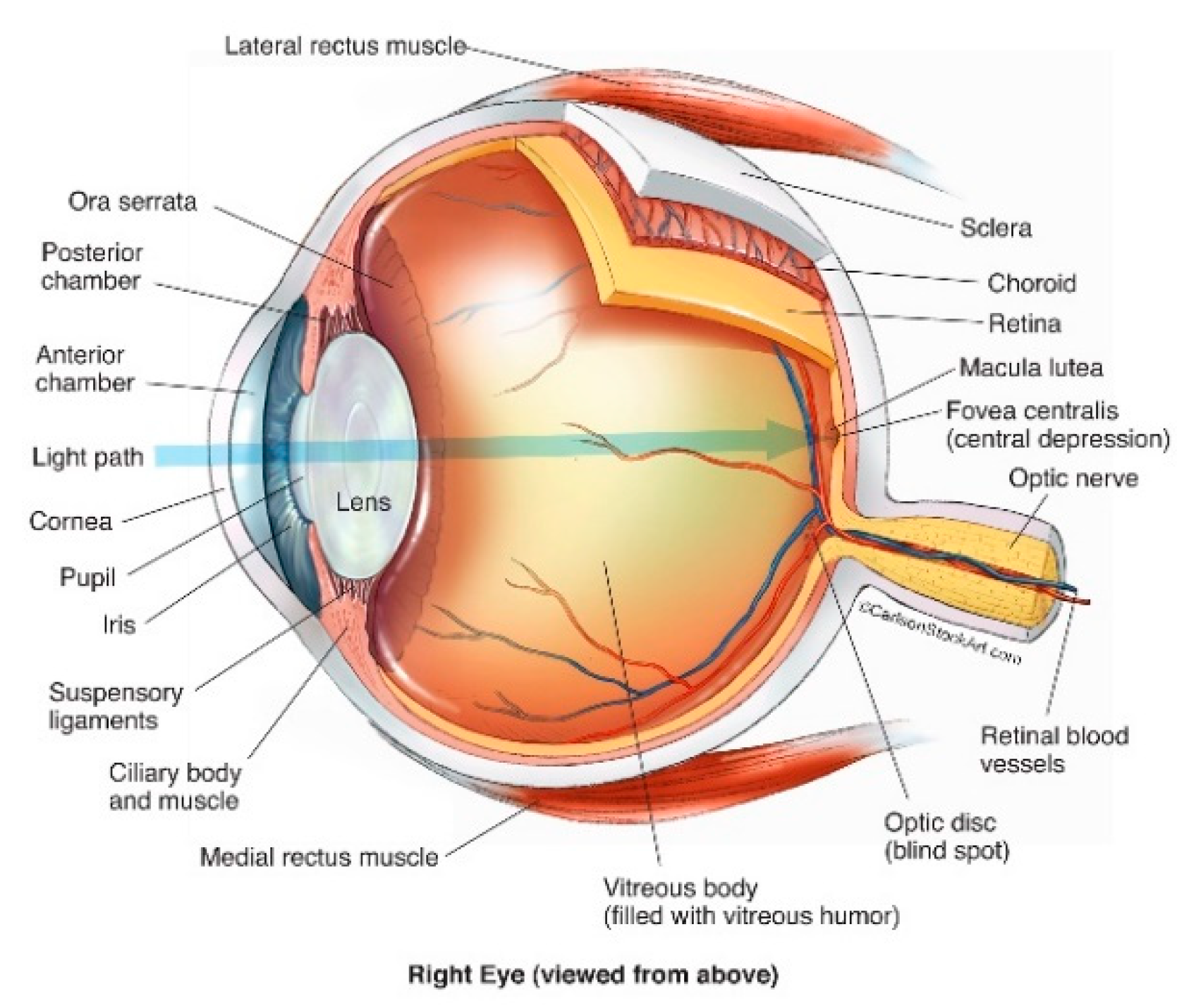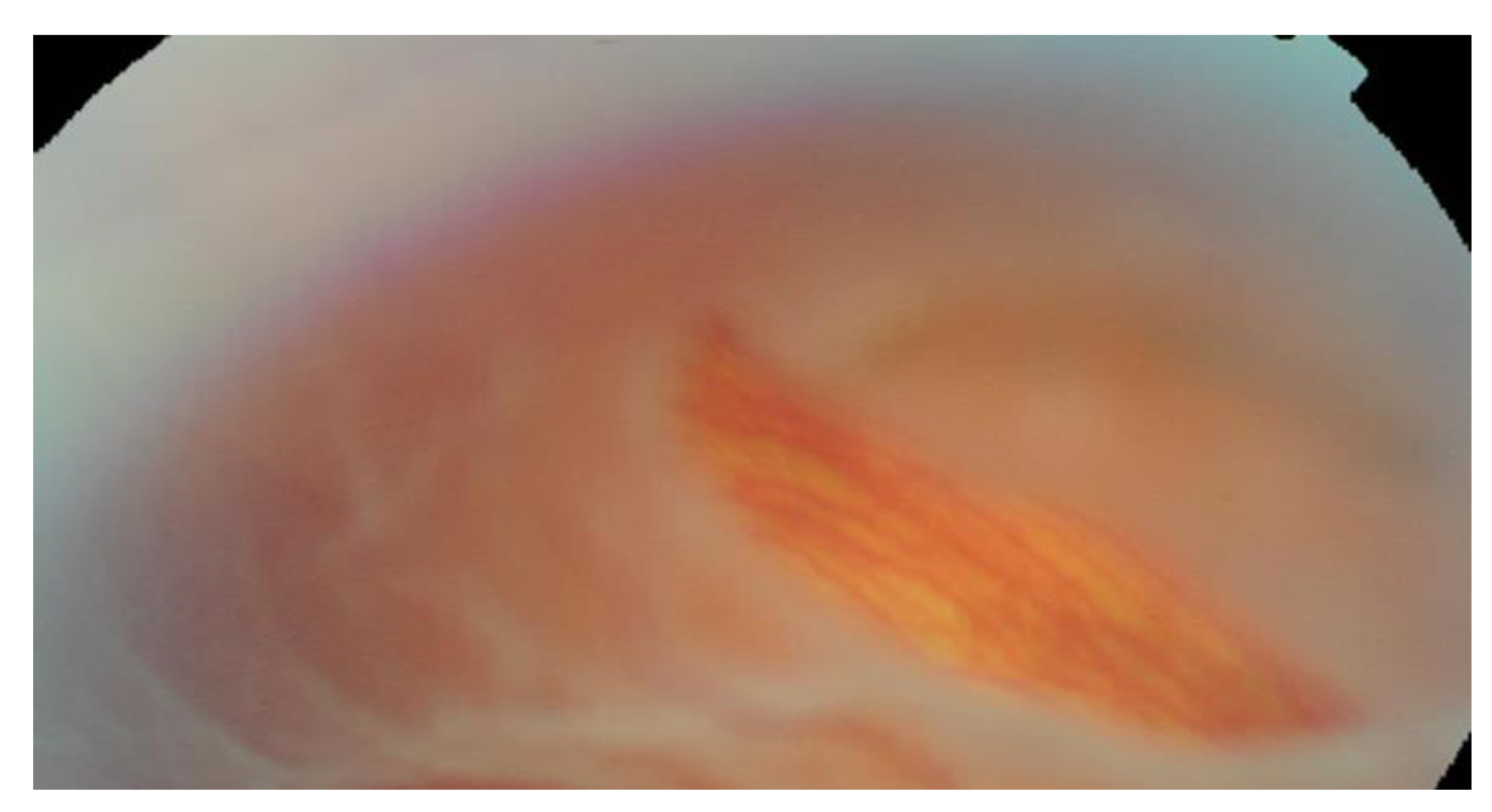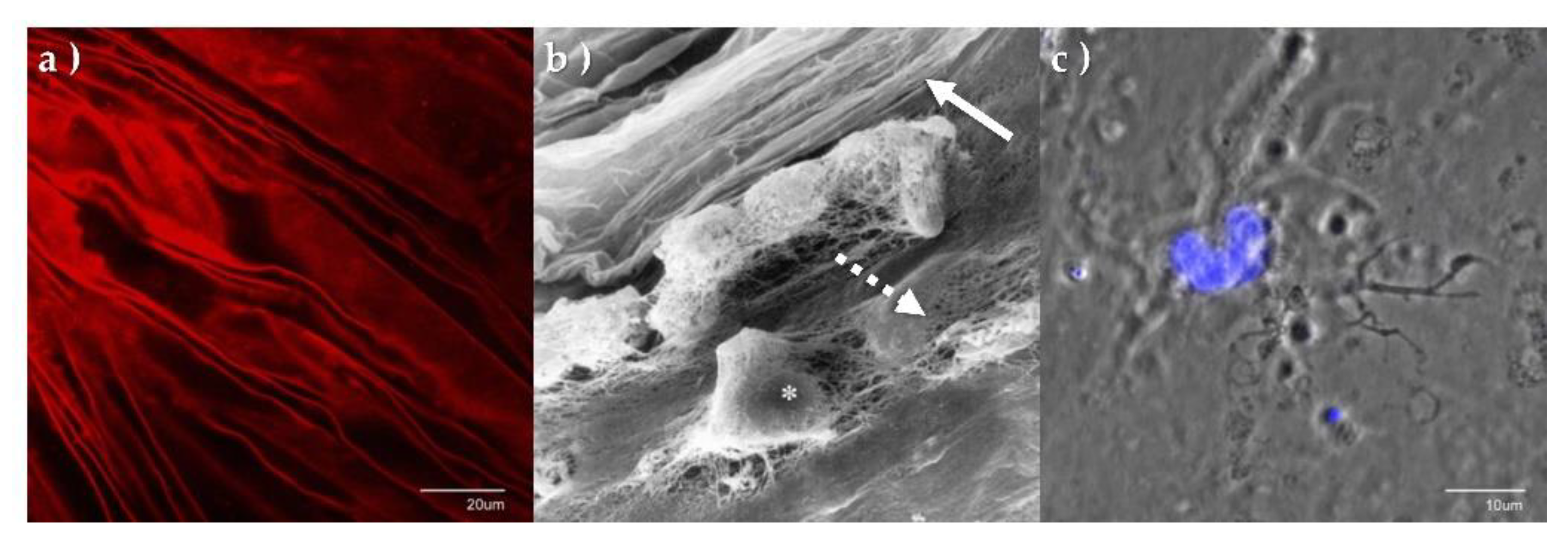A Novel Transcriptome Approach to the Investigation of the Molecular Pathology of Vitreous and Retinal Detachment
Abstract
:1. Introduction
2. Anatomy of the Human Eye
3. Posterior Vitreous Detachment
4. Retinal Detachment
5. Rhegmatogenous Retinal Detachment
5.1. Horseshoe Retinal Tears
5.2. Giant Retinal Tears
5.3. Macular Hole-Associated Retinal Detachment
6. The Laminocyte
7. Discussion and Future Projections
Author Contributions
Funding
Institutional Review Board Statement
Informed Consent Statement
Data Availability Statement
Acknowledgments
Conflicts of Interest
References
- NHS Digital. Latest Figures on Registered Blind and Partially Sighted People in England are Published. 2021. Available online: https://digital.nhs.uk/news/2021/latest-figures-on-registered-blind-and-partially-sighted-people-in-england-are-published (accessed on 17 May 2022).
- Quartilho, A.; Simkiss, P.; Zekite, A.; Xing, W.; Wormald, R.; Bunce, C. Leading causes of certifiable visual loss in England and Wales during the year ending 31 March 2013. Eye 2016, 30, 602–607. [Google Scholar] [CrossRef] [PubMed]
- Kuhn, F.; Aylward, B. Rhegmatogenous retinal detachment: A reappraisal of its pathophysiology and treatment. Ophthalmic Res. 2014, 51, 15–31. [Google Scholar] [CrossRef] [PubMed]
- Sebag, J. Vitreous and Vision Degrading Myodesopsia. Prog. Retin. Eye Res. 2020, 79, 100847. [Google Scholar] [CrossRef] [PubMed]
- Foos, R.Y.; Wheeler, N.C. Vitreoretinal juncture. Synchysis senilis and posterior vitreous detachment. Ophthalmology 1982, 89, 1502–1512. [Google Scholar] [CrossRef]
- Sebag, J. Age-related changes in human vitreous structure. Graefes Arch. Clin. Exp. Ophthalmol. 1987, 225, 89–93. [Google Scholar] [CrossRef] [PubMed]
- Akiba, J. Prevalence of posterior vitreous detachment in high myopia. Ophthalmology 1993, 100, 1384–1388. [Google Scholar] [CrossRef]
- Weber-Krause, B.; Eckardt, C. Incidence of posterior vitreous detachment in the elderly. Ophthalmologe 1997, 94, 619–623. [Google Scholar] [CrossRef]
- Snead, M.P.; Snead, D.R.J.; Mahmood, A.S.; Scott, J.D. Vitreous detachment and the posterior hyaloid membrane: A clinicopathological study. Eye 1994, 8, 204–209. [Google Scholar] [CrossRef]
- Ang, A.; Poulson, A.V.; Snead, D.R.; Snead, M.P. Posterior vitreous detachment: Current concepts and management. Comp. Ophthalmol. Update 2005, 6, 167. [Google Scholar]
- Kakehashi, A.; Takezawa, M.; Akiba, J. Classification of posterior vitreous detachment. Clin. Ophthalmol. 2014, 8, 1–10. [Google Scholar] [CrossRef] [Green Version]
- Snead, M.P.; Snead, D.R.; James, S.; Richards, A.J. Clinicopathological changes at the vitreoretinal junction: Posterior vitreous detachment. Eye 2008, 22, 1257–1262. [Google Scholar] [CrossRef]
- Snead, M.P.; Snead, D.R.; Richards, A.J.; Harrison, J.B.; Poulson, A.V.; Morris, A.H.; Sheard, R.M.; Scott, J.D. Clinical, histological and ultrastructural studies of the posterior hyaloid membrane. Eye 2002, 16, 447–453. [Google Scholar] [CrossRef] [PubMed]
- Fincham, G.; James, S.; Spickett, C.; Hollingshead, M.; Thrasivoulou, C.; Poulson, A.V.; McNinch, A.; Richards, A.J.; Snead, D.; Limb, G.A.; et al. Posterior vitreous detachment and the posterior hyaloid membrane. Ophthalmology 2018, 125, 227–236. [Google Scholar] [CrossRef] [Green Version]
- Snead, D.R.; James, S.; Snead, M.P. Pathological changes in the vitreoretinal junction 1: Epiretinal membrane formation. Eye 2008, 22, 1310–1317. [Google Scholar] [CrossRef] [PubMed]
- Snead, D.R.J.; Cullen, N.; James, S.; Poulson, A.V.; Morris, A.H.C.; Lukaris, A.; Scott, J.D.; Richards, A.J.; Snead, M.P. Hyperconvolution of the inner limiting membrane in vitreomaculopathies. Graefes Arch. Clin. Exp. Ophthalmol. 2004, 242, 853–862. [Google Scholar] [CrossRef]
- Purves, D.; Augustine, G.J.; Fitzpatrick, D.; Katz, F.C.; LaMantia, A.-S.; McNamara, J.O.; Williams, M.S. Neuroscience, 2nd ed.; Sinauer Associates: Sunderland, MA, USA, 2001. Available online: https://www.ncbi.nlm.nih.gov/books/NBK10885/ (accessed on 1 September 2021).
- Snell, R.S.; Lemp, M.A. Clinical Anatomy of the Eye, 2nd ed.; Wiley: New York, NY, USA, 2013; p. 164. [Google Scholar]
- Snell, R.S.; Lemp, M.A. Clinical Anatomy of the Eye, 2nd ed.; Wiley: New York, NY, USA, 2013; pp. 157, 159. [Google Scholar]
- Nickla, D.L.; Wallman, J. The multifunctional choroid. Prog. Retin. Eye Res. 2010, 29, 144–168. [Google Scholar] [CrossRef] [Green Version]
- DaveCarlson/CarlsonStockArt. Available online: https://www.carlsonstockart.com/ (accessed on 25 May 2022).
- Provis, J.M.; Penfold, P.L.; Cornish, E.E.; Sandercoe, T.M.; Madigan, M.C. Anatomy and development of the macula: Specialisation and the vulnerability to macular degeneration. Clin. Exp. Optom. 2005, 88, 269–281. [Google Scholar] [CrossRef]
- Kang, H.K.; Luff, A.J. Management of retinal detachment: A guide for non-ophthalmologists. BMJ 2008, 336, 1235–1240. [Google Scholar] [CrossRef] [PubMed] [Green Version]
- Ankamah, E.; Sebag, J.; Ng, E.; Nolan, J.M. Vitreous Antioxidants, Degeneration, and Vitreo-Retinopathy: Exploring the Links. Antioxidants 2019, 9, 7. [Google Scholar] [CrossRef] [Green Version]
- Silva, A.F.; Alves, M.A.; Oliveira, M.S.N. Rheological behaviour of vitreous humour. Rheol. Acta 2017, 56, 377–386. [Google Scholar] [CrossRef] [Green Version]
- Le Goff, M.; Bishop, P. Adult vitreous structure and postnatal changes. Eye 2008, 22, 1214–1222. [Google Scholar] [CrossRef] [PubMed]
- Sakamoto, T.; Ishibashi, T. Hyalocytes: Essential cells of the vitreous cavity in vitreoretinal pathophysiology? Retina 2011, 31, 222–228. [Google Scholar] [CrossRef] [PubMed]
- Sebag, J. The vitreous. In Adlers Physiology of the Eye, 9th ed.; Hart, W., Ed.; Mosby: St. Louis, MO, USA, 1992; pp. 268–347. [Google Scholar]
- Mitry, D.; Charteris, D.G.; Yorston, D.; Siddiqui, M.A.; Campbell, H.; Murphy, A.L.; Fleck, B.W.; Wright, A.F.; Singh, J. Scottish RD Study Group. The epidemiology and socioeconomic associations of retinal detachment in Scotland: A two-year prospective population-based study. Invest Ophthalmol. Vis. Sci. 2010, 51, 4963–4968. [Google Scholar] [CrossRef] [Green Version]
- Lewis, H. Peripheral retinal degenerations and the risk of retinal detachment. Am. J. Ophthalmol. 2003, 136, 155–160. [Google Scholar] [CrossRef]
- Ghazi, N.; Green, W. Pathology and pathogenesis of retinal detachment. Eye 2002, 16, 411–421. [Google Scholar] [CrossRef]
- Mitry, D.; Charteris, D.G.; Fleck, B.W.; Campbell, H.; Singh, J. The epidemiology of rhegmatogenous retinal detachment: Geographical variation and clinical associations. BJO 2010, 94, 678–684. [Google Scholar] [CrossRef]
- Sultan, Z.N.; Agorogiannis, E.I.; Iannetta, D.; Steel, D.; Sandinha, T. Rhegmatogenous retinal detachment: A review of current practice in diagnosis and management. BMJ Open Ophthalmol. 2020, 5, e000474. [Google Scholar] [CrossRef]
- Sodhi, A.; Leung, L.S.; Do, D.V.; Gower, E.W.; Schein, O.D.; Handa, J.T. Recent Trends in the Management of Rhegmatogenous Retinal Detachment. Surv. Ophthalmol. 2008, 53, 50–67. [Google Scholar] [CrossRef]
- Kirin, M.; Chandra, A.; Charteris, D.G.; Hayward, C.; Campbell, S.; Celap, I.; Bencic, G.; Vatavuk, Z.; Kirac, I.; Richards, A.J.; et al. Genome-wide association study identifies genetic risk underlying primary rhegmatogenous retinal detachment. Hum. Mol. Genet. 2013, 22, 3174–3185. [Google Scholar] [CrossRef] [PubMed] [Green Version]
- Wong, T.Y.; Tielsch, J.M.; Schein, O.D. Racial difference in the incidence of retinal detachment in Singapore. Arch. Ophthalmol. 1999, 117, 379–383. [Google Scholar] [CrossRef] [Green Version]
- Peters, A.L. Retinal detachment in black South Africans. S. Afr. Med. J. 1995, 85, 158–159. [Google Scholar] [PubMed]
- Go, S.L.; Hoyng, C.B.; Klaver, C.C. Genetic risk of rhegmatogenous retinal detachment: A familial aggregation study. Arch. Ophthalmol. 2005, 123, 1237–1241. [Google Scholar] [CrossRef] [PubMed] [Green Version]
- Spickett, C.; Hysi, P.; Hammond, C.J.; Prescott, A.; Fincham, G.S.; Poulson, A.V.; McNinch, A.M.; Richards, A.J.; Snead, M.P. Deep Intronic Sequence Variants in COL2A1 Affect the Alternative Splicing Efficiency of Exon 2, and May Confer a Risk for Rhegmatogenous Retinal Detachment. Hum. Mutat. 2016, 37, 1085–1096. [Google Scholar] [CrossRef] [PubMed] [Green Version]
- Ung, T.; Comer, M.; Ang, A.; Sheard, R.; Lee, C.; Poulson, A.V.; Newman, D.K.; Scott, J.D.; Richards, A.J.; Snead, M.P. Clinical features and surgical management of retinal detachment secondary to round retinal holes. Eye 2005, 19, 665–669. [Google Scholar] [CrossRef] [Green Version]
- Uffelmann, E.; Huang, Q.Q.; Munung, N.S.; de Vries, J.; Okada, Y.; Martin, A.R.; Martin, H.C.; Lappalainen, T.; Posthuma, D. Genome-wide association studies. Nat. Rev. Method Prim. 2021, 1, 59. [Google Scholar] [CrossRef]
- Ross, W.H. Retinal dialysis: Lack of evidence for a genetic cause. Can. J. Ophthalmol. 1991, 26, 309–312. [Google Scholar]
- Freeman, H.M. Fellow eyes of giant retinal breaks. Trans. Am. Ophthalmol. Soc. 1978, 76, 343–382. [Google Scholar]
- Kanski, J.J. Giant retinal tears. Am. J. Ophthalmol. 1975, 79, 846–852. [Google Scholar] [CrossRef]
- Thompson, J.A.; Snead, M.P.; Billington, B.M.; Barrie, T.; Thompson, J.R.; Sparrow, J.M. National audit of the outcome of primary surgery for rhegmatogenous retinal detachment. II. Clinical outcomes. Eye 2002, 16, 771–777. [Google Scholar] [CrossRef]
- Margehria, R.R.; Schepens, C.L. Macular breaks 1. Diagnosis, etiology and observations. Am. J. Ophthalmol. 1972, 74, 219–232. [Google Scholar]
- Morita, H.; Ideta, H.; Yonemoto, J.; Sasaki, K.; Tanaka, S. Causative factors of retinal detachment in macular holes. Retina 1991, 11, 281–282. [Google Scholar] [CrossRef] [PubMed]
- Shea, M.; Schepens, C.L.; Von Pirquet, S.R. Retinoschisis. I. Seniletype: A clinical report of one hundred seven cases. Arch. Ophthalmol. 1960, 63, 1–9. [Google Scholar] [CrossRef] [PubMed]
- Hagler, W.S.; Woldroff, H.S. Retinal detachment in relation to senile retinoschisis. Trans. Am. Acad. Ophthalmol. Otolaryngol. 1973, 77, 99–113. [Google Scholar]
- Verdaguer, J. Juvenile retinal detachment. Pan American Association of Ophthalmology and American Journal of Ophthalmology Lecture. Am. J. Ophthalmol. 1982, 93, 145–156. [Google Scholar] [PubMed]
- Westfall, A.C.; Maa, A.; Mieler, W.; Holz, E. Incidence of retinal tears and late-onset retinal breaks in eyes with symptomatic posterior vitreous detachment. Investig. Ophthalmol. Vis. Sci. 2004, 45, 2066. [Google Scholar]
- Mitry, D.; Singh, J.; Yorston, D.; Siddiqui, M.A.; Wright, A.; Fleck, B.W.; Campbell, H.; Charteris, D.G. The predisposing pathology and clinical characteristics in the Scottish retinal detachment study. Ophthalmology 2011, 118, 1429–1434. [Google Scholar] [CrossRef]
- Boutin, T.S.; Charteris, D.G.; Chandra, A.; Campbell, S.; Hayward, C.; Campbell, A.; Nandakumar, P.; Hinds, D.; UK Biobank Eye & Vision Consortium; 23andMe Research Team; et al. Insights into the genetic basis of retinal detachment. Hum. Mol. Genet. 2020, 29, 689–702. [Google Scholar] [CrossRef] [Green Version]
- Schepens, C.L.; Dobble, J.G.; Mc, M.J. Retinal detachments with giant breaks: Preliminary report. Trans. Am. Acad. Ophthalmol. Otolaryngol. 1962, 66, 471–479. [Google Scholar]
- Snead, M.P. Giant retinal tear. In Essentials in Ophthalmology—Vitreoretinal Surgery; Kirchhof, B., Wong, D., Eds.; Springer: Berlin/Heidelberg, Germany, 2005; pp. 89–100. [Google Scholar]
- Snead, M.P. Retinal detachment in childhood. In Paediatric Ophthalmology and Strabismus, 6th ed.; Lyons, C., Hoyt, C., Eds.; Elsevier Saunders: Philadelphia, PA, USA, 2022. [Google Scholar]
- Ang, G.S.; Townend, J.; Lois, N. Epidemiology of giant retinal tears in the United Kingdom: The British giant retinal tear epidemiology eye study (BGEES). Retina 2010, 51, 4781–4787. [Google Scholar] [CrossRef] [Green Version]
- Shunmugam, M.; Ang, G.S.; Lois, N. Giant retinal tears. Surv. Ophthalmol. 2014, 59, 192–216. [Google Scholar] [CrossRef]
- Chang, S.; Lopez, J.M. Giant retinal tears and proliferative vitreoretinopathy. In Retina, 4th ed.; Ryan, S.J., Ed.; Mosby: St. Louis, MO, USA, 2006; pp. 2345–2351. [Google Scholar] [CrossRef]
- Ang, G.S.; Townend, J.; Lois, N. Interventions for prevention of giant retinal tear in the fellow eye. Cochrane Database Syst. Rev. 2009, 2, CD006909. [Google Scholar] [CrossRef]
- Aylward, G.W.; Cooling, R.J.; Leaver, P.K. Trauma-induced retinal detachment associated with giant retinal tears. Retina 1993, 13, 136–141. [Google Scholar] [CrossRef] [PubMed]
- Chen, S.N.; Li, K.H.; Hwang, J.F. Myopic macular hole-associated retinal detachment with proliferative vitreoretinopathy. Taiwan J. Ophthalmol. 2013, 3, 141–145. [Google Scholar] [CrossRef] [Green Version]
- Spaide, R.F. Staphyloma: Part 1. Pathologic Myopia; Springer: New York, NY, USA, 2014; pp. 167–176. [Google Scholar]
- Ohno-Matsui, K.; Jonas, J.B. Posterior staphyloma in pathologic myopia. Prog. Retin. Eye Res. 2019, 70, 99–109. [Google Scholar] [CrossRef] [PubMed]
- Sugden, C.J.; Iorio, V.; Troughton, L.D.; Liu, K.; Morais, M.; Lennon, R.; Bou-Gharios, G.; Hamill, K.J. Laminin N-terminus α31 expression during development is lethal and causes widespread tissue-specific defects in a transgenic mouse model. FASEB J. 2022, 36, e22318. [Google Scholar] [CrossRef] [PubMed]
- Maumenee, A.E. Further Advances in the Study of the Macula. Arch Ophthalmol. 1967, 78, 151–165. [Google Scholar] [CrossRef] [PubMed]
- Tanenbaum, H.L.; Schepens, C.L.; Elzeneiny, I.; Freeman, H.M. Macular Pucker Following Retinal Detachment Surgery. Arch. Ophthalmol. 1970, 83, 286–293. [Google Scholar] [CrossRef] [PubMed]
- Fincham, G.S. The Prevention and Pathogenesis of Retinal Detachment. Ph.D. Thesis, UCL (University College London), London, UK, 2015. Available online: https://discovery.ucl.ac.uk/id/eprint/1459426/h (accessed on 17 April 2022).
- Sakamoto, T. Cell biology of hyalocytes. Nippon Ganka Gakkai Zasshi 2003, 107, 866–883. [Google Scholar]
- Qiao, H.; Hisatomi, T.; Sonoda, K.H.; Kura, S.; Sassa, Y.; Kinoshita, S.; Nakamura, T.; Sakamoto, T.; Ishibashi, T. The characterisation of hyalocytes: The origin, phenotype, and turnover. Br. J. Ophthalmol. 2005, 89, 513–517. [Google Scholar] [CrossRef]
- Ferenbach, D.; Hughes, J. Macrophages and dendritic cells: What is the difference? Kidney Int. 2008, 74, 5–7. [Google Scholar] [CrossRef] [Green Version]
- Reeves, S.A.; Helman, L.J.; Allison, A.; Israel, M.A. Molecular cloning and primary structure of human glial fibrillary acidic protein. Proc. Natl. Acad. Sci. USA 1989, 86, 5178–5182. [Google Scholar] [CrossRef] [PubMed] [Green Version]
- Lazarus, H.S.; Hageman, G.S. In situ characterization of the human hyalocyte. Arch. Ophthalmol. 1994, 112, 1356–1362. [Google Scholar] [CrossRef] [PubMed]
- Noda, Y.; Hata, Y.; Hisatomi, T.; Nakamura, Y.; Hirayama, K.; Miura, M.; Nakao, S.; Fujisawa, K.; Sakamoto, T.; Ishibashi, T. Functional properties of hyalocytes under PDGF-rich conditions. Investig. Ophthalmol. Vis. Sci. 2004, 45, 2107–2114. [Google Scholar] [CrossRef] [PubMed] [Green Version]
- Donato, R.; Cannon, B.R.; Sorci, G.; Riuzzi, F.; Hsu, K.; Weber, D.J.; Geczy, C.L. Functions of S100 proteins. Curr. Mol. Med. 2013, 13, 24–57. [Google Scholar] [CrossRef] [PubMed] [Green Version]
- Bumgarner, R. Overview of DNA microarrays: Types, applications, and their future. Curr. Protoc. Mol. Biol. 2013, 101, 22.1.1–22.1.11. [Google Scholar] [CrossRef] [Green Version]
- Zhao, S.; Fung-Leung, W.P.; Bittner, A.; Ngo, K.; Liu, X. Comparison of RNA-Seq and microarray in transcriptome profiling of activated T cells. PLoS ONE 2014, 9, e78644. [Google Scholar] [CrossRef]
- Rao, M.S.; Van Vleet, T.R.; Ciurlionis, R.; Buck, W.R.; Mittelstadt, S.W.; Blomme, E.; Liguori, M.J. Comparison of RNA-Seq and Microarray Gene Expression Platforms for the Toxicogenomic Evaluation of Liver from Short-Term Rat Toxicity Studies. Front. Genet. 2019, 9, 636. [Google Scholar] [CrossRef]
- Byron, S.; Van Keuren-Jensen, K.; Engelthaler, D.; Carpten, J.D.; Craig, D.W. Translating RNA sequencing into clinical diagnostics: Opportunities and challenges. Nat. Rev. Genet. 2016, 17, 257–271. [Google Scholar] [CrossRef]
- Kukurba, K.R.; Montgomery, S.B. RNA Sequencing and Analysis. Cold Spring Harb. Protoc. 2015, 11, 951–969. [Google Scholar] [CrossRef] [Green Version]
- Papaspyropoulos, A.; Lagopati, N.; Mourkioti, I.; Angelopoulou, A.; Kyriazis, S.; Liontos, M.; Gorgoulis, V.; Kotsinas, A. Regulatory and Functional Involvement of Long Non-Coding RNAs in DNA Double-Strand Break Repair Mechanisms. Cells 2021, 10, 1506. [Google Scholar] [CrossRef]
- Roberts, K.; Aivazidis, A.; Kleshchevnikov, V.; Li, T.; Fropf, R.; Rhodes, M.; Beechem, J.M.; Hemberg, M.; Bayraktar, O.A. Transcriptome-wide spatial RNA profiling maps the cellular architecture of the developing human neocortex. bioRxiv 2021, in press. [Google Scholar] [CrossRef]




| Break Type | PHM * Status | Vitreous Architecture | Sex | Typical Age Group (Years) | Refractive Error | Fellow-Eye Involvement Pathology | Reference |
|---|---|---|---|---|---|---|---|
| Atraumatic dialysis | On | Normal | M > F | 8–20 | Emmetropia/hypermetropia | 5–15% | [42] |
| Giant retinal tear | Off | Check for anomaly | M = F | 5–50 | Moderate/ high myopia | Variable up to 80% | [43,44] |
| Horseshoe tear | Off | Usually syneretic | M = F | 45–65 | Moderate/ high myopia | 10% | [45] |
| Round retinal hole | On | Usually normal | F > M | 20–40 | Moderate myopia | 45% | [40] |
| Macular hole | Off | Syneretic | M = F | 45–65 | High myopia | Rare | [46,47] |
| Degenerative retinoschisis | On | Normal | M > F | 70+ | Hypermetropia | 80% | [48,49] |
| X-linked retinoschisis | On | Normal, may have haemorrhage | M | 10–20 | Emmetropia | 100% | [50] |
Publisher’s Note: MDPI stays neutral with regard to jurisdictional claims in published maps and institutional affiliations. |
© 2022 by the authors. Licensee MDPI, Basel, Switzerland. This article is an open access article distributed under the terms and conditions of the Creative Commons Attribution (CC BY) license (https://creativecommons.org/licenses/by/4.0/).
Share and Cite
Maranian, M.; Snead, M. A Novel Transcriptome Approach to the Investigation of the Molecular Pathology of Vitreous and Retinal Detachment. Genes 2022, 13, 1885. https://doi.org/10.3390/genes13101885
Maranian M, Snead M. A Novel Transcriptome Approach to the Investigation of the Molecular Pathology of Vitreous and Retinal Detachment. Genes. 2022; 13(10):1885. https://doi.org/10.3390/genes13101885
Chicago/Turabian StyleMaranian, Mel, and Martin Snead. 2022. "A Novel Transcriptome Approach to the Investigation of the Molecular Pathology of Vitreous and Retinal Detachment" Genes 13, no. 10: 1885. https://doi.org/10.3390/genes13101885





